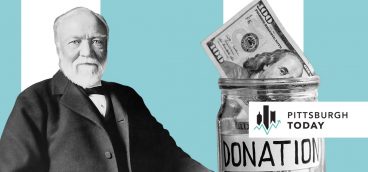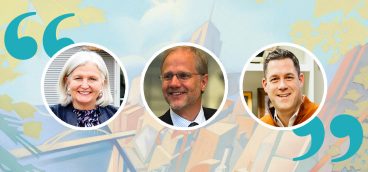The Template for Sustainable Development

It was several years ago that Pittsburgh Mayor Bill Peduto was chatting with André Heinz, soon to be chairman of The Heinz Endowments, about development in Pittsburgh— specifically, Hazelwood’s Almono site, where the foundation is a principal. The more they talked, the more they realized they shared a vision for a new type of growth in Pittsburgh, development that emphasizes inclusiveness, environmental sensitivity and sustainability.
“I knew he was very knowledgeable on a global scale,” Peduto recalls, “but I didn’t realize he had the passion to try to see it in Pittsburgh.”
The men spoke several times more and got their colleagues and staff involved in a new initiative based on that shared vision of development. It’s called People, Planet, Place and Performance, p4 for short, and it has the potential to redefine the city’s landscape and development processes—indeed, the way the city views itself. Grant Oliphant, president of The Heinz Endowments, calls p4 “an attempt to shock the system with a conversation about what world-class excellence looks like.”
“We think Pittsburgh is on the cusp of a dramatic new wave of development and redevelopment,” Oliphant says, “and that it will be making decisions over the next five, maybe 10 years that are likely to shape the future of this community for at least a generation to come.
“Actually, we’re not just on the cusp of the wave—we’re in it. You can see it in East Liberty and the development pressure that’s already swept over Lawrenceville. We’re seeing development pressures throughout the city.
“The question for us is how do we do this right?”
“Actually, we’re not just on the cusp of the wave—we’re in it.”
—Grant Oliphant, Heinz Endowments
While the city and the foundation were the original forces behind p4, they knew that such a portentous undertaking would require additional input and support. Now, p4 partners include The Brookings Institution, Fourth Economy, Joshua Franzos, Neighborhood Allies, PolicyLink, Push 7, ReMake Group LLC, Sustainable Pittsburgh, Urban Institute, UrbanKind Institute and Wall-to-Wall Studios. The group has staged two events here that brought together the best minds and most successful practitioners in sustainable development. While the initial conference in 2015 was focused relatively broadly, the second edition concentrated on the human component.
“Community sensitivity around the people and place components has risen in the past year precisely because of the development pressures we’re talking about,” Oliphant says. “There’s a growing realization that we don’t want this next wave of development to leave people behind. We don’t want it to exclude the very people who live here now or destroy the inherent character of the neighborhoods that make Pittsburgh so special.”
With two conferences under its belt, p4 is poised to produce a concrete result— a new set of development guidelines for the city. Called Performance Measures, the parameters could bring far-reaching changes to the way public funds are awarded for development projects.
“It will be an actual test card of measuring each development that asks for public subsidy, instead of arbitrarily awarding grants and tax breaks,” Peduto says.
Heading the metrics project is Rebecca L. Flora, a respected development veteran in Pittsburgh whose experience includes tours with the Urban Redevelopment Authority of Pittsburgh (URA), the U.S. Green Building Council and Ecology & Environment, Inc. Currently, Flora is president and CEO of ReMake Group, a consulting company. More than 100 stakeholders contributed to the creation of the Performances Measures—here are the 12 that emerged:
AIR — Provide high-quality air to create healthy ecological systems
COMMUNITY — Engage the community early to understand needs and align interests
CONNECT — Enhance and expand transportation options
DESIGN — Promote long-lasting design that contributes to local identity and includes public art or local artisanship
ECONOMY — Use public investment to leverage private investment
ENERGY — Reduce energy consumption and climate impact
HOUSING — Provide diverse, affordable options that create stable communities
INNOVATION — Advance and foster ideas that stimulate creative solutions to complex urban challenges
LAND — Reactivate abandoned/derelict lots to return them to productive use
OPPORTUNITY — Drive economic prosperity through inclusive, equitable development
PUBLIC — Extend the public realm to provide quality indoor and outdoor spaces
RAINWATER — Manage rainwater to minimize impact; reuse rainwater as a resource
In their proposals for funding, developers long have addressed some of these concerns. They’re interested, for example, in returning vacant property to productive use; that’s been the dominant theme of recent brownfield redevelopment in the region. And the primary reason they apply for public funding in the first place is to leverage private investment. Yet ask developers how many rain barrels they propose and what they intend to do with the water and you may give them the willies. That’s why Flora recommends a period of education and transition.
“Based on my experiences throughout the world with rating systems, I think we really have something special here,” Flora says. “The next big step will be to teach people how to begin to use the measures and apply them to their projects. We have to allow the market to catch up and start using the measures so they feel comfortable with them.”
Flora introduced the performance measures to local developers at two roundtable discussions and describes their reaction as “fairly positive.”
“People felt like, for those who are doing this type of work already, this will be a way of being rewarded for that,” she reports. “For others, as long as we’re not making this an absolute requirement right now, they’ll feel comfortable that this is something to move toward.”
At the URA, which would be the agency most responsible for day-to-day application of the Performance Measures, Acting Executive Director Robert Rubinstein also suggests that a period of adjustment may be in order.
“We look forward to using and embracing (the measures), but with any given project, there may be only eight of the 12 categories that apply,” he said. “Our projects come to us at different stages, from different sources and venues and are seeking different types of assistance. It will be interesting to test the various projects that we encounter on a daily basis, see how many can go through this process and what, if any, limitations there are.”
Transitional phase or no, Peduto minces no words about his ultimate goal for the Performance Measures.
“They become part of the Pittsburgh Code. They need to be because they’re not for one administration only if they’re to become part of Pittsburgh’s DNA.”
Interestingly, neither The Heinz Endowments nor Peduto sees p4 as a regional play initially, except in matters of urgent common interest, such as transportation.
“The greatest pressure right now is how to create quality, sustainable urban environments,” Oliphant says. “We see Pittsburgh at Ground Zero in that dynamic.
“We really want to focus on where the action will yield the greatest benefit. Realistically, that means the City of Pittsburgh primarily.”
Or, as Peduto told p4 participants: “We’re small enough that we can do it; we’re large enough that the world will take note.”




